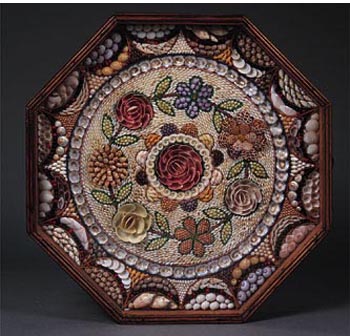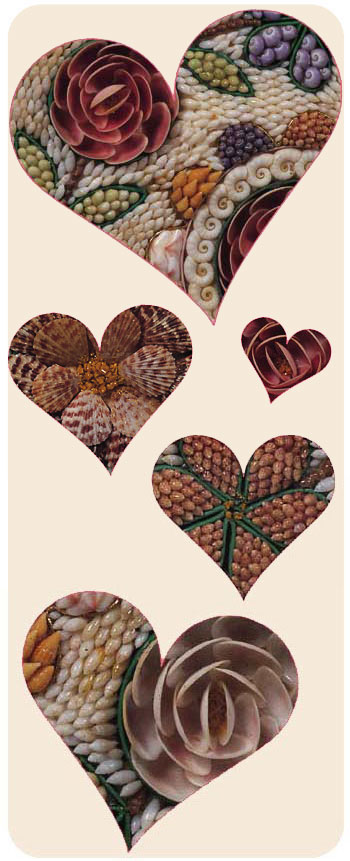Sailor's Valentines
With the recent publication of a creatively designed octagonal book devoted solely to sailors’ valentines,1 it is evident that interest in these intricate nineteenth-century shell-work souvenirs continues to increase. In a relatively short amount of time, sailors’ valentines have gained both recognition and status in the world of collecting. A small double valentine that twenty years ago sold for $350 to $600, now sells for $3,500 to $8,500, and the price for a large double valentine has jumped from $1,000 to between $8,500 and $18,000.
Sailors’ valentines were gifts from sailors to their sweethearts that often included affectionate sayings with their designs. For many years, collectors and scholars thought that sailors made these decorative objects during their long voyages at sea. While sailors made items such as scrimshaw and wool works aboard vessels,2 they would not have had access to the variety of shells, paper, glass, and wood necessary to make these valentines. Research has also shown that they were made specifically for the souvenir trade, mainly in the West Indies.
Though there are some valentines that incorporate the sayings “Gift from Trinidad” or “Present from St. Lucia,” most of the known valentines are associated with Barbados. From the 1630s to the turn of the twentieth century, Barbados, located at the easternmost point of the British West Indies, was an important English and later American port of call for goods such as sugar, rum, lumber, and fish. In the nineteenth century, a souvenir culture thrived in response to sailors hoping to bring back mementos of their travels. Since shells were a natural commodity on the islands, they were incorporated into a variety of decorative items—from picture frames to cameo work. Production of valentines reached its height in the mid- to late nineteenth century, with some earlier examples known. The Victorian love for collecting and displaying exotic objects from afar possibly fueled the industry and no doubt played to the enthusiasm for the valentines, which comprised hundreds of shells in intricate designs.
While some Barbadians may have had their own cottage industry, local merchants apparently hired islanders to make valentines, which the retailers then sold in their shops. This business arrangement is based on the label of B. H. Belgrave, who operated a shop on McGregor Street in Barbados. His label, “Dealer in Marine Specialties and Native Manufacturer in Fancy Work,” is occasionally found glued to the bottoms of valentines that often incorporate the words “Gift from Barbados” or “Present from Barbados.” Occasionally, Barbadian newspapers back the cotton batting onto which the shells and seeds are glued. The shells used to decorate most valentines are indigenous to the island, further substantiating Barbados as the place of manufacture for the majority of these curiosities.
Traditional valentines (Fig. 1) are octagonal in shape and consist of two boxes hinged to one another, hence the term double valentines. Occasionally a large single valentine will come on the market, but typically, single valentines have been separated from their other halves. Generally made with mahogany sides and top and Spanish cedar bottoms, the insides of the boxes are lined with colored paper, often pink, on which cotton batting is placed. Shells and seeds are then glued in mosaic-like patterns, often repeating similar design templates; colored paper placed on edge serves to delineate the design. Glass is inset on each side to protect the valentine when the box is open.
Sentiments typically appear only on the smaller 9 1/2-inch double valentines, which often incorporate a heart design on the other half. Some of the more popular phrases include “To My Sweetheart,” “To My Love,” “Home Again,” and “From a Friend.” The larger 13 1/2- to 14-inch examples rarely have sayings, but display more intricate shell-work designs on both sides, most commonly a compass rose in combination with a heart.
There is a distinctive group of boxes (Fig. 2) that offers a variation on the classic type of valentines. These are of exceptional quality, both in the workmanship of the boxes and the intricacies of the shell designs, which incorporate smaller and brighter shells and more complex arrangements. Although still octagonal in shape, they were never made as hinged doubles, only as single valentines. They are covered with a wooden-bordered glass top hinged on one side. Whereas the standard valentines are closed with a brass hook and eye, here, ivory escutcheons embellish the keyholes. Stylistically these valentines seem more modern in design than those dating to the 1840s and 1860s and were probably made between 1870 and 1880.
Each example in this group of distinctive valentines displays complex decorative schemes, the same selection of shells, and use of colored and gold foil papers. The designs show a large center section filled with tiny rice shells that create a field of white in which a wreath or basket of flowers comprises the major section. The leaves, flowers, or basket are framed with bright green borders of paper in which the shells then form the pattern within. Around this striking composition is a circle of S-shaped snail shells or brown-tipped beige oval shells with a border of medium-blue paper. Further swag-like designs are bordered by orange and yellow paper that, in turn, form sixteen semicircles filled with shells that repeat every eight sections, to the edge of the box, which is covered in pale pink paper.
The origin of these fine valentines is a mystery. The boxes are made of veneered mahogany and their construction is much more sophisticated than the standard valentine boxes, and required the skill of a trained cabinetmaker. There was a tradition of furniture makers in Barbados, many trained by those who had worked with immigrant English craftsmen active on the island in the 1770s and 1780s. It is possible that these rare examples were products of a select Barbadian cabinet shop. It is also possible that these valentines were made in London. With the English craze for Victorian shell work, it is quite probable that a British retailer, aware of the Barbadian examples brought back by sailors, recognized a market niche for finer valentines and arranged for their London manufacture. This scenario would also support the incorporation of an unprotected glass lid, which would not have been conducive to long sea voyages. Less than half a dozen of these valentines are known, also lending to the probability that they were not made for the souvenir trade, but for a distinct elite clientele.
Condition is important when considering the purchase of a sailor valentine. The work should retain most of its shells and the box should be as damage free as possible. The more desirable valentines will incorporate motifs other than the heart and compass rose design, such as anchors, vases of flowers, or exceptionally detailed single flowers. Valentines with mottos indicating purchase from Barbados, or those with sailors’ photographs, are generally more trinket-oriented and not as desirable as those with sentimental mottos of love and friendship.
-----
Diana H. Bittel has been in the antique business for twenty-five years, dealing in nautical works of art and sailors’ valentines since 1977. She exhibits at The Philadelphia Antiques Show, Southport-Westport, Nantucket Historical Association, Ellis Memorial Antiques Show, The Delaware Antiques Show, and the Washington Antiques Show, where she will continue to offer valentines as often as she can find them.
2. Wool works, or woolies, were needlework pictures sewn in wool on materials, such as sackcloth, available aboard ship. Images often depicted sailing vessels or patriotic scenes.















.jpg)


















